Canada 2006
Montréal, 30 Sep 06 – 3 Oct 06
Montréal is the largest city in French-speaking province of Quebec and was the first destination on our trip. Happily for me, virtually everyone is bilingual.
Samual de Champlain arrived in 1611 to set a trading post on the island that Montreal now completely fills so he could barter European manufactured goods for furs of animals captured by the native peoples. However, the founding of the city is usually set at 1642 when a few dozen colonists arrived with the aim of converting the indians and started Ville-Marie or the City of Mary.
The bilingual city is a result of events in 1760, when the French surrendered to British forces although formal control was not handed over until the Treaty of Paris in 1763. Then something interesting happened. After a decade of failing to make the French colonists British, the British passed the Quebec Act in 1774 over the objections of English merchants recognizing French law, the Catholic religion and the use of French language. Prior to that Catholics were excluded from public office. So the colonists were able to continue French culture although Lan says that she often could not understand what they were saying as their French is so different to that spoken in France. I imagine the differences are similar to those between BBC English and that of African-Americans, those from the deep South or rural Australia.
At Chateaux Ramezay, the governor’s house, I learned the single most interesting thing of the whole trip—that America had attempted to invade Canada in 1775 during the Revolutionary War. The Americans wanted to get the British out of all of North America and prior to hostilities, Benjamin Franklin had visited Montreal to determine if he could get French Canadians to join in the uprising. However, the British had given the French-speaking and Catholic people of "Lower Canada" a reasonably good deal that allowed them to keep their language and religioni so Franklin came away disappointed. He was later to comment that "It would have been easier to buy Canada than invade it"
Incidentally, the Americans tried to invade again in 1812. Thomas Jefferson had forcast that capturing Canada would "merely be a matter of marching" since the populace would rise up against the British and join in to overthrow the Crown. It didn’t happen but the conflict finally settled the borders between the two countries.
There is one feature of the city that can’t be adequetely shown in pictures and that is the network of underground shops and train stations that allow you to get around a good bit of downtown without needing to go outside. This map might give you some clue though you really have to walk it to fully comprehend it. Given the ferocity of winter, this is a marvellous innovation though one of the guidebooks noted that there was no real plan but developers kepting adding more to the system. I believe Toronto has something similar.
Learn more about Montreal.
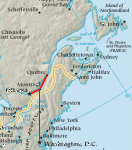
Cartier arrived in the Gulf of St. Lawrence in 1534 and explored as far as Québec and then Montréal the following year.
We flew to Montréal in 2006 then rented a car to get to Québec and Ottawa.
Incidentally, note the historical anomaly of St. Pierre and Miquelon that are the only remaining French territories in North America.

Strangely empty for a pleasant Sunday afternoon.
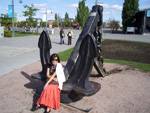
Lan wasn't feeling as strong as when this photo was taken so she sat on the anchor rather than lifting it.

Named for the French navigator who pushed up the Gulf of St Lawrence in 1535 hoping to find a strait to the Pacific but instead found the navigable water ended at what is now Montreal. Seeing a large hill on the island, he climbed it and named it Mount Royal, thus giving the future city its name
Now the pedestrian mall is the center of thronging with tourists—including me
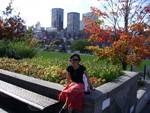
This is at the corner of a small square at the top of Place Jacques Cartier where there is a statue of the man looking down towards the river. He also looks up at a statue of the English admiral Nelson on a much taller column that was erected after the British gained control in 1763.

The town hall, as seen from Place Jacques Cartier.
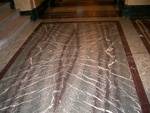
I've never seen anything like it. The builders have obtained green marble with brown stripes and white inclusions and then cut slices, opening them up like pages of a book so the patten is mirrored.

As we left the Town Hall, we had to sneak past the bride and groom who were posing for photos. We had to take one too —from a discreet distance.
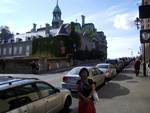
In fact, this is a picture of the back of the building since I didn't think to take a photo of the front. It was built for Claude de Ramezay, the French governor of Montreal 1703-24 and is now a museum.
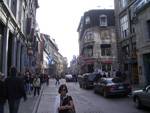
A quarter of the town burned down in 1765 and subsequent building regulations mandated building in stone.

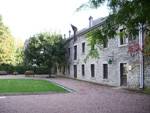
In fact, the Frommer’s guidebook comments that the real stables were next door and that this building was used mainly as a warehouse.

This wall and its immediate neighbors are all that remains of the chapel that was part of a hospital here 1693–1851. Marguerite d'Youville founded the hospital and later the Sisters of Charity of Montreal. I wonder if the Gray Nuns description refers to their uniform or their hair.

Formerly the central fire station. We didn't go in.

When Lan originally thought of going to Canada, she suggested going to Halifax which is on the Atlantic. Then she regained contact with a friend that she had not seen since leaving Vietnam in 1981 and since Nguyet lives with her family in Montreal, we decided to go there instead.
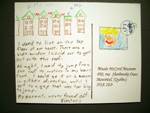
The McCord museum of Canadian History opens with an exhibit called "Growing up in Montreal" which among other things mentioned that one in four families have a single parent and that Montreal has the most poverty of Canadian cities. I think 70% of residents are renters and most live in 3 or 4-storey buildings. Visitors, young and old, are invited to share their recollections and there is a wall of the most interesting. If you are a parent, you’ll find this one hair-raising!
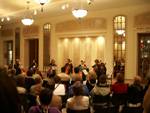
It was still raining when we left the McCord museum so we ventured on to the Museum of Fine Arts. We heard this group tuning up and since we had tired feet, it was an easy decision to grab a seat to be ready when they started. I don't like classical music but I enjoyed it anyway. There was a boy of perhaps 5 two rows ahead of us who bounced up and down on his chair in the livlier bits.

I should have taken some notes on what this is. I think it was Chinese. I know it was old.
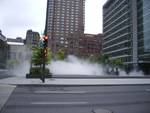
By the time the signal turned to green, we realized that the cloud was not mist from the fountain but steam from the manhole cover at the bottom of the picture.
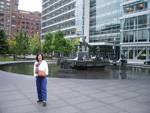
We passed this fountain on Rue de Bleury several times as it was between our hotel on Boul Rene Levesque and old town. René Lévesque was the driving force behind a movement to break the province of Quebec away from Canada and though he was unsuccessful, there is a major road named after him in both Montreal and Quebec City.

Caught red handed.

I don't know anything about it except that I liked it.
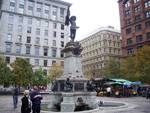
The town square is opposite the main cathedral and the guy on the statue is Paul de Chomedey, sieur de Maisonneuve, the founder of the city. At this spot where the French colonists defeated the Iroquois who were attempting to throw them off the island.

Although the church is in the style of those in Europe that are many hundreds of years old, this dates only from 1829, replacing an earlier structure that was too small. It is nevertheless an impressive building and the inside was more interesting than I expected.
They had adopted what I thought was a sensible policy to pay for the building's upkeep - charge tourists Can$4 to come have a look and take a shorted guided tour.

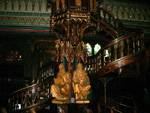
This photo is a testament to the usefulness of photo editing software since the original was very dark. In large spaces, flash is useless and gives weird color to the objects close by so the only hope is to allow the camera to pick maximum exposure time (¼ second) and try to hold the camera steady.
\r\nFor reasons that I don\'t remember explained, the pulpit from which the priest delivers the sermon, was not at the front but halfway down one side so those in the front of the church would have to twist in their seats to see him. I guess the arrangement didn\'t suit a lot of people so the ornate pulpit was replace by another, less elaborate one, at the front.
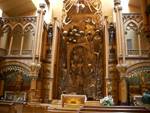
The guide said that after the impressive main church was completed, some members complained it was just too big for many occassions such as weddings and so an annex, albeit a richly decorated one, was built on the back of the church. Unfortunately, a fire destroyed most of it in 1978 so what we see now is quite modern.
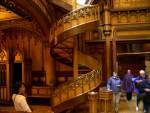
There was another on the other side of the aisle, presumably for symmetry since I don't recall there being large galleries on the upper level.
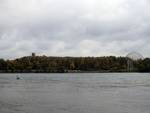
Montreal sits on an island so not all the water on the river flows through the section of the river you see here. Indeed, the land on the other side is an island too. There are a few things to note here:
- The green navigation buoy is not sitting vertically but is being dragged downstream on its chain by the strong current.
- The building visible on the rise is part of The Old Fort and Stewart Museum which would visit later but since no photographs were allowed, I have nothing to show you; it covered the history, particularly the military history, of the area.
- The hemispherical thing on the right is the Biosphere. More later.

We considered walking over the bridge in the background to get to the island but decided it was too far. We walked a good distance instead to and from the railway stations though we had a pleasant, if brief, encounter with a student from Tunisia on the train. He was concerned that we looked lost but it turned out that he had been in the city only a month or two.
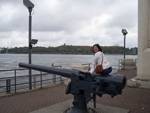
Enemy boats coming up river would have to face Lan a half-dozen guns here and others elsewhere.

After WW1, many believed that it was the "war to end all wars". Sadly it wasn't so it appears that after WW2, extra text was added in the limited space left at the bottom.

Originally built as the US exhibition space for the 1967 World Expo (educational facility run by Environment Canada.
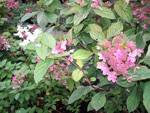

Montreal hosted the summer Olympics in 1976, remembered locally mainly for going way over-budget and everywhere else for Nadia Comaneci's perfect 10s in gymnastics. The Wikipedia entry for the Games amusingly reports that "After a rainstorm that doused the Olympic flame a few days after the games had opened, an official relit the flame using his cigarette lighter"!

Apparently the tower was completed only after the Olympics and the retractable roof never worked properly.

We were very lucky with the weather when we went to the Gardens as the weather was looking somewhat threatening but we took a chance and it got better making for a pleasant afternoon. Here Lan pretends to be a lion.
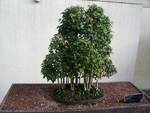
I was unaware of the different styles of bonsai but the Montreal Gardens had a nice selection, including this one in the "forest" style.

However, to me it seems a bit cruel to deliberately stunt the growth of a living thing, even a plant.
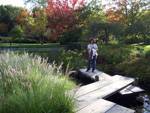
"Lan, take one step back. "

Lovely, especially as the sun came out.
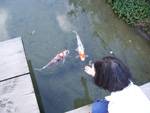
Very peaceful.
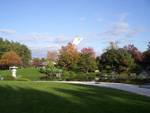
The sloping Montreal Tower is quite striking. We saw a large inclinator (inclined elevator) go up the outside and from the top you can supposedly see 80km/50 miles.

Cute yellow flowers outside the Insectarium..
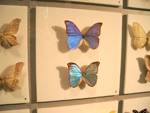
I wish I'd taken this again with the flash on. The backing board is white.

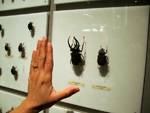
Given the size of its front pincers, this is one bug you would want to stay away from. I wish I had noted what it was.

The body on this one is about 20cm/8" long. I saw one in Auburn (Sydney) that I'm sure I measured at 30cm/12" long!

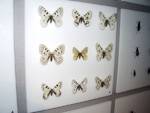

It may happen every year but there was a festival of lanterns when we were there.


This was just a taste of things to come

... and ducks in the background.
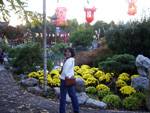
Not posed like most of the pictures I take of Lan.


There's that tower again too.
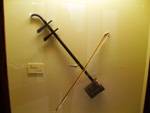
I didn't take a picture of her but this erhu was in a display case so we could see up close the instrument she was playing. A very pleasant sound, especially as it has only two strings.


This was the best time of day to see the various illuminated sculptures but by then it was getting uncomfortably cold. The gardens stayed open till 9pm but we had had enough.
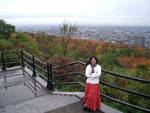
We rented a car for our last day in Montreal and drove up the mountain that gave the city its name. Given the weather, the view was disappointing though there were flashes of fall colors in the trees.


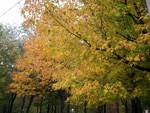
It seemed we were a little early for the display of fall colors though in some places later in the trip we saw trees that had just gone brown so perhaps it was too wet or too dry this year.
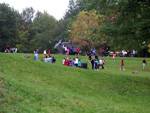
It seemed that they had some unsupervised time to run around, chase the sea gulls and throw rocks in the lake. The ground was still wet from all the rain though and we saw one girl who had clearly fallen often as her clothes were filthy.

In fact, the Oratory, or basilica, was only finished in 1967 so it isn't old. There was a museum of nativity scenes in the basement with a lady very willing to pounce on visitors demanding donations. I would have gladly skipped that bit.
Although it seats 10,000 and gets 2 million visitors a yaer,I'm curious to know how many turn up at an average Sunday Mass. The building seemed overbearing and forbidding to me.
I'd be surprised if they heat the whole thing in Montreal's brutal winter—the average temperature in January is -10°C (13°F)! There is a chapel under the main church which would be better insulated and with a low ceiling so perhaps they use that. I wondered the same thing at Notre Dame.

Beautiful steps though it seemed that actual worshippers entered the building which is on the top of a hill through a series of tunnels and escalators to save effort and keep out of the weather.

The Fur Trade at Lachine National Historic Site of Canada is in the background. It is quite a small museum but nicely summed up the importance of fur trading to the establishment of what we now call Canada. There is a magnificient canoe inside for 10 people but it was too dark to photograph.
The North West company based in Montreal competed with the Hudson's Bay company based at York Factory and as fur-bearing animals, particularly beaver, were hunted to near extinction in one area, traders moved further into the interior to work with Indian trappers. Although Europeans brought with them diseases and alcohol, the Indians did benefit from other tradegoods such as steel tools, so not all the influences were bad. The Europeans needed the Indians to prosper.
The canal was completed in 1825 and allowed navigation around the Lachine Rapids. Previously, goods coming downsteam had to be off-loaded at Lachine and taken overland to Montreal.
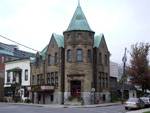
I think this building is now residential though I'm guessing it was built as a commercial structure. I love it though it needs a good cleaning and it's a shame that the the wing on the far left is not matched on the right.

Unable to immediately think of how to fill in the rest of the afternoon, we sat down by the waterfront but soon decided it was too cold and the view too boring

French at the top; English at the bottom—as the people of Quebec like it.

... or in English (by modified machine translation), "I assure you that when I was shown this place, my hair stood on end, to see this so terrible place, and astonished me as the late ones had been if except judgement to pass a so appalling place"
– Samual de Champlain, observing the tumult of the rapids which he named Sault Saint-Louis in memory of his companion Louis, the day after his drowning in 1611.

In fact, the rapids didn't appear particularly frightening to me—from the safety of the shore.
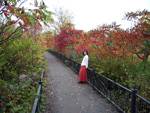
We met a park volunteer shortly after this photo was taken who told us about the area. He said that last winter was mild with the quiet pools off the river freezing to a depth of only 22"/55cm. I was surprised that he gave a measurement in inches as I assumed French Canada would have adopted metric with France after the Revolution but I learned later that Canada only went metric in the 1970s‐about the same time as Australia. Metrification has been held back somewhat by having non-Metric America over the border so standard Canadian office paper is American "letter" instead of A4.
.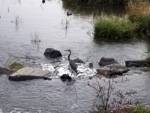
Just near the rapids, a small amount of water leaks off the main river through a pond and over these rocks.
